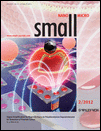Enhanced Nanoscale Imaging of Polymer Blends by Temperature-Controlled Selective Dissolution
Graphical Abstract
Nanoscale imaging on polymer blends is vital, especially in organic electronics. By using temperature-controlled selective dissolution, the 3D structure of a thin film becomes accessible without the expensive search for adequate orthogonal solvents. The method, which takes advantage of the temperature dependence of the solubility, is demonstrated to image P3HT:PCBM and P3HT:F8TBT photovoltaic blend films using atomic force and scanning electron microscopy.





